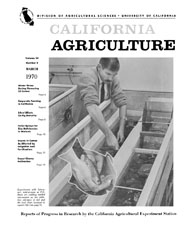


University of California
California Agriculture
|
|||
|
|||

Cover:
Experiments with laboratory mini-streams at U.C. Davis are yielding needed information on the pollution tolerance of fish and the food chain involved in aquatic life
March 1970
Volume 24, Number 3 General Information |
|||
|
University of California, 1301 S. 46th St., Bldg. 478 Richmond, CA
|